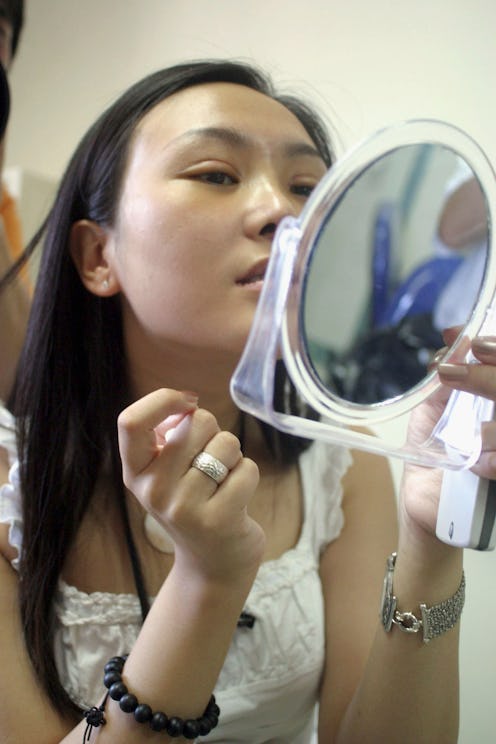Fashion
How Do We Talk About Ethnic Plastic Surgery?
Before today, I knew vaguely that ethnic plastic surgery, or cosmetic surgery to change features that are considered typical of a certain race or ethnicity, existed. As a first-year at the University of Virginia, I roomed with a girl whose family was from South Korea. She lived in a heavily Korean community, and one day she commented to me that she'd considered getting a nose and eyelid job as a high-schooler. "It's really common for my friends," she said. "Lots of them get it as a graduation gift, even if they're really pretty. They'll get the eyelid folds, and maybe a smaller, cuter nose."
"Oh," I said. I sneaked a glance at her lids. Unlike mine, they had no clearly-delineated folds. She had often sighed while watching me put on makeup, telling me that she couldn't wear eye shadow like me. "Your eyelids are fine, though, don't you think?"
"I don't know." She shrugged. "Could be better."
And then I promptly forgot about the topic until I read Maureen O'Connor's essay on ethnic plastic surgery in this week's New York Magazine. The first such surgery was performed in 1896 in order to modify the face of a Japanese woman who had one monolid and one creased lid. In 1926, the U.S. was abuzz with the story of Shima Kito, who went under the knife in order to please his sweetheart, Mildred. By looking more Caucasian (and changing his name to William White), Kito was able to persuade Mildred to marry him. Today, surgeries like blepharoplasties (reshaping the eyelids) and rhinoplasties (reshaping the nose) are so common that they hardly cause people to bat an eyelash. In 2013, 221,000 people got a nose job, while 216,000 had their eyelids redone. They were the second- and third-most popular cosmetic surgery procedures, respectively. Eyelid surgery in particular was more popular, with a 6 percent increase from 2012.
So how do we wade into the murky waters of the ethnic plastic surgery conversation? It's a highly controversial subject, as it rests at the crossroads of so many social and historical conventions: beauty standards, whitewashing, colonialism, ethnicity, race relations ... the list goes on. It's especially problematic (even scary) for me to discuss these issues, since I am a white woman, and whitegirlsplaining is, obviously, bad. Here is the issue that is perhaps at the center of the whole discussion: Are people who get ethnic plastic surgery trying to emulate other races? If they are, is that always bad?
The answer is far more complex than you might think. In her NYMag piece, O'Connor speaks with Dr. Robert Flowers, a pioneer in the plastic surgery field. Flowers, who did much of his work in Hawaii, operated on a large number of Asian women.
“The general idea then—and I keep hearing it even today—was that Asians who have facial and eyelid surgery want to ‘Westernize,’ ” says Flowers. “And that’s even what Asian plastic surgeons thought they were doing then as well. But that’s not what Asians want. They want to be beautiful Asians.”
So what, then, is a beautiful Asian — or a beautiful African American, or a beautiful Latina? In O'Connor's piece, many plastic surgeons seem to hold up stereotypical Caucasian features as the most desirable. For example, O'Connor opens her essay by recording a conversation she had with Dr. Edward Kwan:
“You’ve got some nice Caucasian features,” Dr. Edmund Kwan says, inspecting my face at his Upper East Side plastic-surgery practice, where the waiting room includes an ottoman larger than my kitchen table. “You’re half-Asian mixed with what?” Chinese mom and white dad, I reply. “You inherited a Caucasian nose. Your nose is nice. Your eyes have a little bit of Asian mixed in...You’ve got nice big eyes,” he admits, but eyelids more like my father’s would make them look bigger.
Which all sounds suspect to me. "Nice Caucasian features"? Huh? In that light, I highly recommend that you read through the entirety of O'Connor's article, and that you also check out the comments section on Jezebel's coverage. Many readers are rebelling against the notion that rhinoplasties and blepharoplasties mean conforming to a white idea of beauty, and a 2011 article by New York Times writer Sam Dolnick confirms this dichotomy of opinions surrounding such procedures:
"As the demand for surgical enhancement explodes around the world, New York has developed a host of niche markets that allow the city’s many immigrants to get tucks and tweaks that are carefully tailored to their cultural preferences and ideals of beauty."
For example, many Russian women get breast enhancements, while Italians get their knees reshaped and Iranians get nose jobs. A Latina woman, Italia Vigniero, declared in the NYT article that she wanted her breasts enlarged and her buttocks lifted because “We Latinas define ourselves with our bodies. We always have curves ... [and] my personality doesn’t go with small breasts."
This all dovetails strangely with my experiences last week using the Beauty Mirror app. The changes it made to my face fit the general mold of beauty in the U.S., so much of which is influenced by Western European cultures: bright, sparkling skin, a chiseled chin, a pert (but not huge) nose, plump lips, arched brows like Cara Delevingne, large eyes, and so on. Should I attribute that to chance — or just the standards of beauty held by the app's creators?
Whew, OK. I think it's time for me to take a breather on this one, but just remember to be courteous and considerate when discussing topics like this. They're important to talk about, but productive conversation only comes from thoughtful discourse.
Images: Getty
